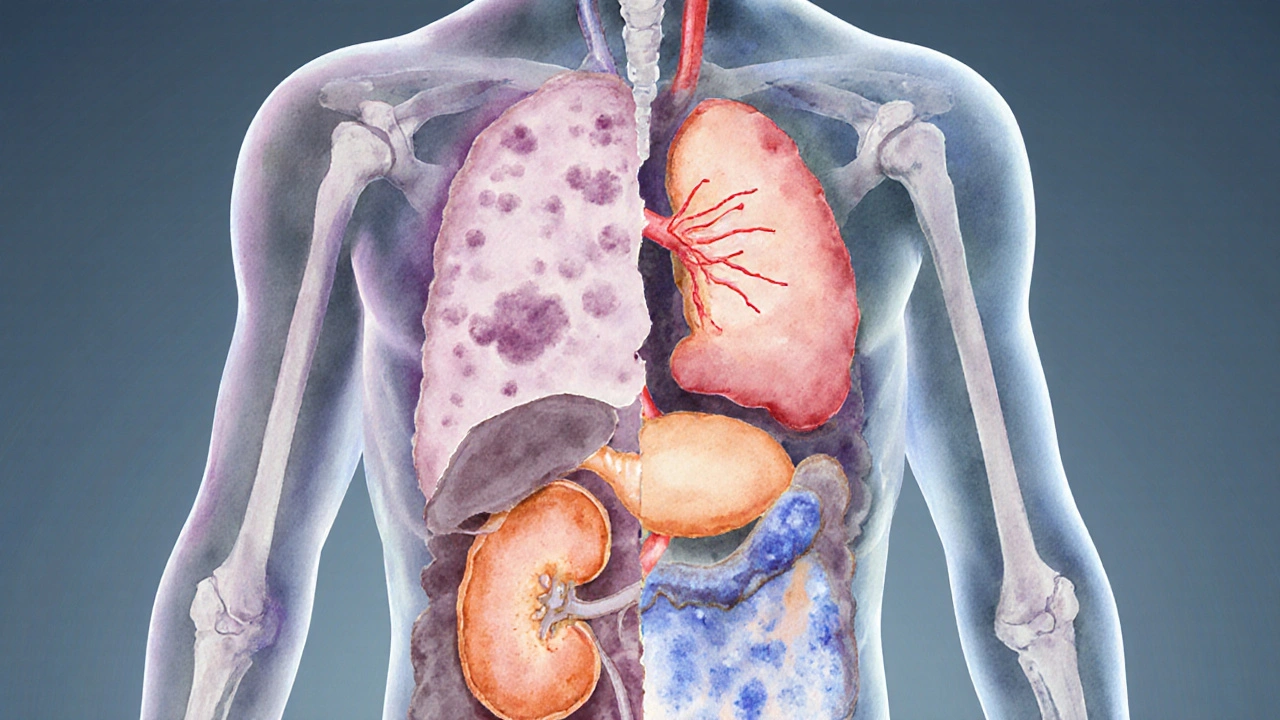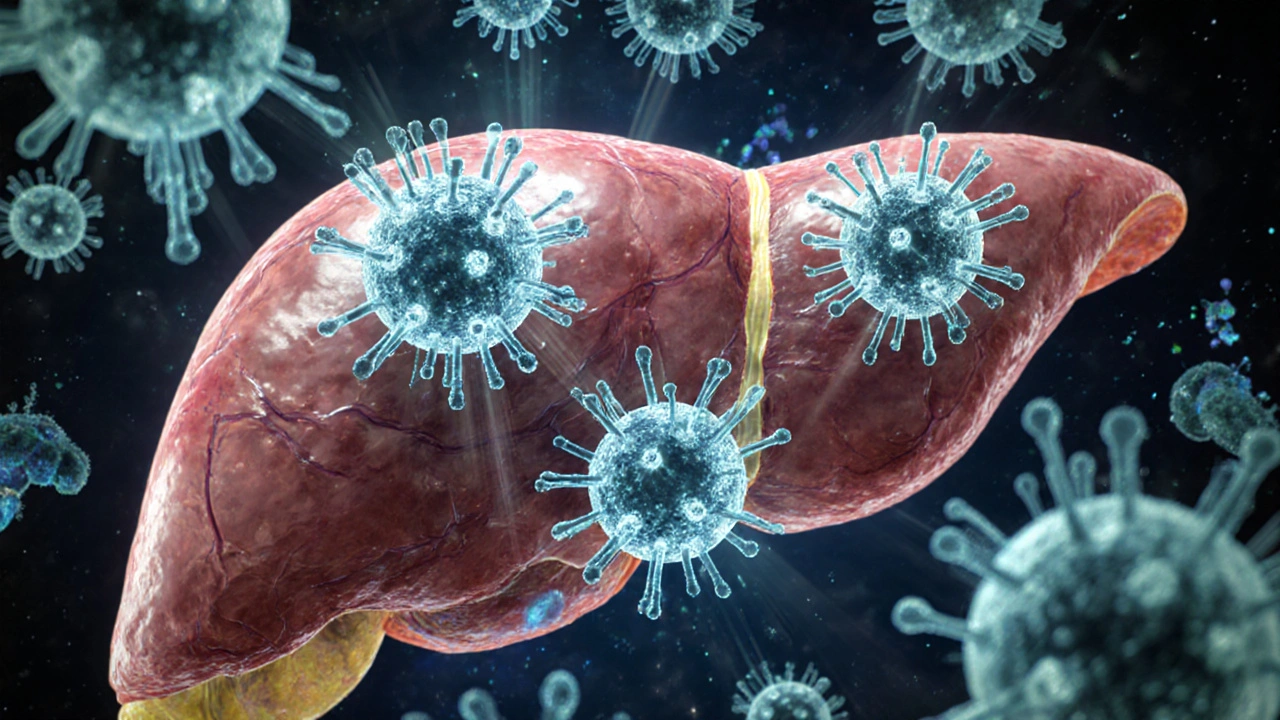Hepatitis C Autoimmune Risk Calculator
What if a virus that lives in your liver could also turn your immune system against itself? When you hear about Hepatitis C virus a blood‑borne RNA virus that primarily infects liver cells, you probably think of cirrhosis or liver cancer. Yet a growing body of evidence shows this virus can set off a cascade of immune disturbances that lead to a variety of autoimmune diseases. This article untangles the connection, explains why it matters for patients and clinicians, and outlines what you can do about it.
Key Takeaways
- Chronic hepatitis C (CHC) can provoke autoimmunity through persistent immune activation and formation of immune complexes.
- Common extra‑hepatic autoimmune manifestations include mixed cryoglobulinemia, systemic lupus erythematosus, rheumatoid arthritis, Hashimoto thyroiditis, and type‑1 diabetes.
- Diagnosing autoimmune disease in CHC patients requires a combined approach: serology, biopsy when needed, and careful exclusion of drug‑induced effects.
- Treatment with direct‑acting antivirals (DAAs) dramatically reduces viral load and often resolves autoimmune symptoms, but interferon‑based regimens can worsen them.
- Early detection and coordinated care between hepatologists and rheumatologists improve outcomes and quality of life.
Why Does a Liver Virus Matter to the Immune System?
The liver is a central immunological organ. It filters blood, presents antigens to immune cells, and produces acute‑phase proteins. When Hepatitis C virus establishes a chronic infection, it creates a state of low‑grade inflammation that persists for years or decades. This chronic exposure leads to three key mechanisms that favor autoimmunity:
- Immune‑complex formation: Viral RNA and antibodies combine to form circulating immune complexes. These deposits can lodge in small vessels, triggering vasculitis and cryoglobulin precipitation.
- Molecular mimicry: Some viral proteins share structural motifs with self‑antigens. The immune system, primed to attack HCV, may inadvertently target similar host proteins.
- Persistent B‑cell activation: HCV infects B‑lymphocytes directly, leading to clonal expansion and production of autoantibodies.
These pathways are not mutually exclusive; they often overlap, creating a perfect storm for autoimmune disease.
Common Autoimmune Conditions Linked to Chronic Hepatitis C
Not every person with CHC develops autoimmunity, but several conditions appear at higher rates than in the general population. Below is a quick snapshot of the most frequently reported diseases.
| Condition | Approx. prevalence in CHC patients | Typical symptoms | Key pathophysiology |
|---|---|---|---|
| Mixed cryoglobulinemia | 10‑20% | Palpable purpura, arthralgia, renal involvement | Immune‑complex deposition in small vessels |
| Systemic lupus erythematosus (SLE) | ~1% | Butterfly rash, photosensitivity, nephritis | Autoantibody production (anti‑DNA, anti‑Sm) |
| Rheumatoid arthritis | 2‑5% | Symmetrical joint swelling, morning stiffness | Synovial inflammation driven by citrullinated peptides |
| Hashimoto thyroiditis | 3‑7% | Fatigue, weight gain, cold intolerance | Anti‑thyroid peroxidase antibodies |
| Type‑1 diabetes mellitus | 0.5‑1% | Polyuria, polydipsia, rapid weight loss | β‑cell autoimmunity (GAD‑65 antibodies) |

Spotting the Signs: When to Suspect an Autoimmune Overlap
Because many of these diseases share nonspecific symptoms-fatigue, joint pain, skin rashes-clinicians rely on a combination of clues:
- Lab red flags: Elevated rheumatoid factor, low complement levels (C4), cryoglobulin positivity, or newly appearing antinuclear antibodies (ANA) in a patient with known CHC.
- Organ‑specific manifestations: Rapidly progressive kidney disease, unexplained neuropathy, or thyroid dysfunction that cannot be attributed solely to liver disease.
- Treatment‑related patterns: Worsening of symptoms after initiating interferon‑α therapy suggests a drug‑induced autoimmune flare.
Early referral to a rheumatologist or endocrinologist can prevent permanent organ damage.
Diagnostic Pathway: From Suspicion to Confirmation
Once an autoimmune process is suspected, a step‑wise work‑up helps narrow the diagnosis:
- Serology: Check ANA, anti‑dsDNA, anti‑CCP, thyroid peroxidase antibodies, and cryoglobulin levels.
- Complement testing: Low C3/C4 points toward immune‑complex disease like cryoglobulinemia.
- Imaging/biopsy: Ultrasound for thyroid nodules, joint ultrasound for synovitis, kidney biopsy if glomerulonephritis is suspected.
- Viral load assessment: Quantify HCV RNA to gauge whether ongoing replication is driving immune activation.
Crucially, clinicians must differentiate between true autoimmune disease and “autoimmune‑like” phenomena that resolve after viral eradication.
Treatment Landscape: What Works and What Doesn’t
Since 2014, direct‑acting antivirals (DAAs) have become the standard of care for HCV. Their impact on autoimmunity is two‑fold:
- Viral clearance: By eliminating the source of chronic immune stimulation, DAAs often lead to remission of cryoglobulinemic vasculitis and may improve other autoimmune manifestations.
- Rapid improvement: Studies from 2022‑2024 show that 60‑70% of patients with HCV‑related mixed cryoglobulinemia achieve clinical remission within 12weeks of DAA therapy.
In contrast, the older interferon‑α regimen can exacerbate or even trigger autoimmune disease. Interferon boosts Th1 responses, heightening autoantibody production. Therefore, interferon is now reserved for very select cases where DAAs are contraindicated.
When an autoimmune disease persists after HCV cure, disease‑specific treatment is indicated. For example, rituximab (an anti‑CD20 monoclonal antibody) is effective for refractory cryoglobulinemic vasculitis, while standard disease‑modifying antirheumatic drugs (DMARDs) manage rheumatoid arthritis.

Managing Co‑Morbidities: A Team‑Based Approach
Patients with CHC and autoimmunity often juggle multiple specialists. A coordinated care plan should include:
- Regular liver function tests to monitor fibrosis regression after DAAs.
- Autoimmune disease activity scores (e.g., SLEDAI for lupus) to track symptom trends.
- Vaccination updates (influenza, pneumococcal, hepatitisA/B) because immunosuppression can heighten infection risk.
- Lifestyle counseling-avoid alcohol, maintain a balanced diet, and stay physically active to support liver health and reduce systemic inflammation.
Electronic health records with shared notes improve communication and reduce duplicated testing.
Future Directions: What Research Is Telling Us
Ongoing studies are exploring why only a subset of CHC patients develop autoimmunity. Genetic predisposition (HLA‑DRB1*04), gut microbiome alterations, and the role of extracellular vesicles are hot topics. Recent 2025 data suggest that patients with high baseline cryoglobulin titers benefit from a combined DAA‑plus‑rituximab regimen, achieving faster remission than antivirals alone.
As treatment options expand, clinicians will have more tools to tailor therapy to each patient’s immunological profile.
Take‑Home Checklist for Patients and Providers
- Screen all chronic HCV patients for autoantibodies at baseline.
- Consider DAAs as first‑line therapy; avoid interferon when autoimmune disease is present.
- Monitor for new‑onset rash, joint pain, or renal changes after HCV diagnosis.
- Collaborate across specialties-hepatology, rheumatology, endocrinology.
- Educate patients about the link between HCV and autoimmunity to encourage early reporting of symptoms.
Frequently Asked Questions
Can curing hepatitis C eliminate an existing autoimmune disease?
In many cases, especially mixed cryoglobulinemia, viral eradication leads to remission. However, diseases like systemic lupus erythematosus may persist and require continued immunosuppressive therapy.
Why do some hepatitis C patients develop autoantibodies while others don’t?
Genetic factors (e.g., specific HLA alleles), the duration of infection, and co‑existing infections or gut‑microbiome imbalances influence the likelihood of autoantibody formation.
Is it safe to start immunosuppressive medication while waiting for hepatitis C treatment?
Caution is advised. Immunosuppression can increase viral replication and liver inflammation. Ideally, initiate DAAs first; if disease activity is severe, a short‑term, low‑dose regimen may be considered under close monitoring.
What laboratory tests are most useful for detecting HCV‑related autoimmunity?
Key tests include ANA, anti‑dsDNA, rheumatoid factor, anti‑CCP, anti‑thyroid peroxidase antibodies, complement C3/C4 levels, and cryoglobulin quantification.
Do lifestyle changes impact the risk of autoimmunity in hepatitis C patients?
Yes. Limiting alcohol, maintaining a healthy weight, and avoiding smoking reduce liver inflammation and overall immune activation, potentially lowering autoimmune risk.

Benton Myers
October 10, 2025 AT 15:56Interesting rundown on how Hep C can set off auto‑immune issues. The risk calculator seems handy for patients trying to gauge their situation. It’s good to see age and infection duration factored in, since those are real markers. Also, the symptom checklist covers the usual suspects without overwhelming the user.
Pat Mills
October 11, 2025 AT 05:33Honestly, this whole auto‑immune link feels like another piece of the grand pharma agenda. They throw in neat charts and calculators to make us think it’s all science, but it’s just a way to push more tests and meds. The inclusion of family history is a classic bait to get people scared about genetics. And let’s not forget the subtle suggestion that alcohol consumption matters – they’re nudging us toward lifestyle policing. The whole thing reeks of control, not care.
neethu Sreenivas
October 11, 2025 AT 05:41💖 The way the article lays out the risk factors is really clear, especially for folks who aren’t medical experts. It’s nice that they keep the language simple and the calculator interactive – that helps demystify a complex topic. 😊 Also, acknowledging symptoms like fatigue and joint pain makes it more relatable. Thanks for making health info accessible!
Keli Richards
October 11, 2025 AT 19:26Appreciate the straightforward presentation. The sections are well‑structured and the risk categories are easy to understand.
Ravikumar Padala
October 11, 2025 AT 19:31Seems like they’re over‑complicating things. A simple questionnaire would do.
King Shayne I
October 12, 2025 AT 09:20Look, if you’re really worried about auto‑immune fallout you should get tested ASAP. No point messin’ around with calculators; get a doc’s opinion.
jennifer jackson
October 12, 2025 AT 09:21Great tip! Quick checks can really help you stay on top of things.
Brenda Martinez
October 12, 2025 AT 23:13This article really hits the nail on the head about how hidden the autoimmune triggers can be. It’s a shame most people don’t realize that a chronic virus can mess with the immune system in such subtle ways. The calculator adds a nice interactive element, showing that it’s not just theory. I love how they broke down the symptoms – it makes the whole thing less scary. Still, I wish they’d dive deeper into the mechanisms, not just the surface.
Marlene Schanz
October 12, 2025 AT 23:16Adding a bit more detail on how HCV proteins mimic host tissues could give readers a better grasp of molecular mimicry. Also, a note about treatment options like direct‑acting antivirals would round it out nicely.
Dharmendra Singh
October 13, 2025 AT 13:06The integration of lifestyle factors, like alcohol intake, shows a holistic view of risk. It’s helpful that the tool doesn’t just rely on lab values but also on real‑world habits. This can encourage patients to consider small changes that might lower their overall risk.
Rocco Abel
October 13, 2025 AT 13:15Don’t trust the mainstream narrative – they hide the truth about how viruses manipulate our immune response.
Dawn Mich
October 14, 2025 AT 03:00They’re overhyping the calculator.
Eric Sevigny
October 14, 2025 AT 03:05While the calculator is a useful start, it would benefit from linking to peer‑reviewed studies for those who want to dig deeper.
Glenda Rosa
October 14, 2025 AT 16:53Ah, another feel‑good health piece that pretends to be neutral while quietly feeding the pharma pipeline. The language sounds scientific, but it’s just another way to get people to think they need fancy tests.
charlise webster
October 14, 2025 AT 16:58If you look closely, the risk scores are arbitrarily assigned; the article doesn’t explain the weighting methodology.
lata Kide
October 15, 2025 AT 06:46Whoa, this is a rollercoaster of a read! 🌪️ First off, the idea that chronic Hep C can act like a sneaky puppet master, pulling the strings of our immune system, is both fascinating and terrifying. 😱 It’s like the virus is playing chess while our bodies are stuck on checkers. The article does a solid job breaking down the basics – age, infection duration, family history – those are the obvious chess pieces, but then it dives into the deep end with symptom counts and alcohol consumption, making it feel like the entire board is in play.
What really blew my mind is the mention of molecular mimicry – the virus produces proteins that look just enough like our own proteins to confuse the immune guards. That’s a masterstroke of deception, and it explains why autoimmune flare‑ups can pop up years after the initial infection. The calculator itself is a neat interactive tool; you punch in your info and bam, you get a risk tier. It’s straightforward, but don’t be fooled – the underlying science is anything but simple.
One thing I wish they’d add is a discussion about how direct‑acting antivirals (DAAs) have changed the game. Those meds can clear the virus in a fraction of the time it used to take, which might also lower the autoimmune trigger potential. Also, a little note on how diet and stress management could modulate the immune response would give the piece an extra layer of practicality.
Overall, this post is a solid blend of layperson‑friendly explanation and enough geek‑stuff to keep the science‑curious satisfied. It makes the hidden link between Hep C and autoimmunity feel less like a conspiracy and more like a genuine, worrying reality that deserves attention. Keep the deep dives coming! 🚀
Mark Eddinger
October 15, 2025 AT 06:48The article could benefit from a clearer definition of the scoring algorithm, as the current description leaves room for interpretation.
Francisco Garcia
October 15, 2025 AT 20:40I appreciate the balanced overview and the interactive element. It gives readers a tangible way to assess their own risk without feeling overwhelmed. Adding references to recent studies on HCV‑induced autoimmunity could further enhance credibility.